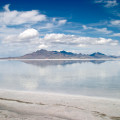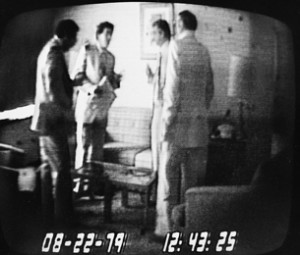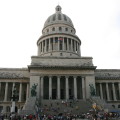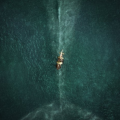The Donner Party: Suffering on the American Plains
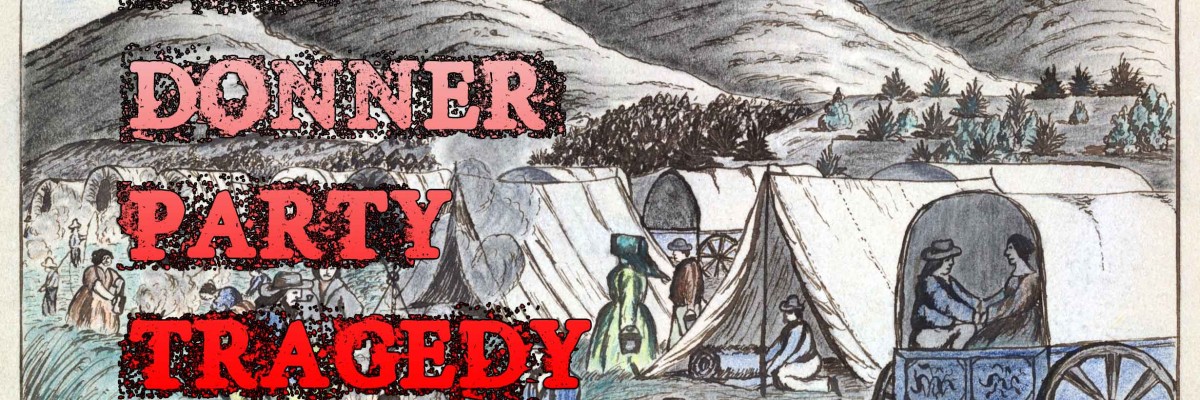
Imagine yourself reading an ad that offered adventure, free land, and the chance to see a part of the world that was barely touched by human hands. If you’re the adventurous type, you’d jump on the prospect. In 1846, a trip with roughly 80 participants, bound as friends by the pioneer spirit and the desire to see the Mexican province of Upper California, set across the Great Plains. Men, women, and children of all ages, cattle, horses, ponies, and all manner of supplies were a part of the wagon train. A city on wheels, it extended for more than 2 miles in single file.
At journey’s end, 39 of the 87 who set out with this group, the Donner Party, would tell a story of violence, revenge, illness, and a desperate starvation, the likes of which has become American folklore.
An Easy Start for the Donner Party
Setting out from Springfield, the Donner Party had an easy time. They crossed the plains quickly and without any major incidents. Coming from an area where relations between settlers and native American populations was strained, they were pleasantly surprised by the assistance of a Caw tribe at a river crossing, and later by the peaceful and curious companionship of the Sioux for a few days of their journey.
The weather in July of 1846 was pleasant, and the Donner Party celebrated Independence Day, happy and excited. Virginia Reed Murphy, the daughter of the expedition’s organizer John Reed, remembers her family looking eastward at a pre-arranged time, as their friends in Illinois looked westward, and toasting the holiday.

James & Margaret Reed, members of the Donner Party. Photo via wikipedia.
Men in the caravan hunted buffalo meat, and the supplies were plentiful. Buffalo steak was a common feast in the camps. Just a few short weeks later, the pioneers’ luck would change. The Donner Party was fated to become one of the most notorious caravans in the history of the American West, and it all started at Hasting’s Cut-off.

Hasting’s Cutoff Map. Photo via wikipedia.
Ill-fated Choices, Thirst, and Murder
Hasting’s Cut-off was located just a short drive past Fort Bridger. At this point on the journey, the Donner Party left a much larger wagon train to travel the new road. They’d been persuaded by a new guidebook, and were expecting easy crossings and a promised savings of 100 miles off their journey. Unfortunately, the guidebook was wrong.
The new path cost them hundreds of miles, along which the group faced harsh desert on the far side of Salt Lake Utah that left the livestock and their human companions parched. It was at this point that John Reed and his family lost their cattle, who were set free of their yolks to search for water, and were never seen again. As a result, the Reed family also lost all but one of their wagons, and the vast majority of their supplies. The Reeds would soon face a greater struggle – one that would forever alter the outcome of the Donner Party.
Great Salt Lake desert. Photo via wikipedia.
Observing a quarrel between two men, John Reed intervened. The anger of one of the men, a good friend of John Reed’s named John Snyder, soon turned on Reed. The other man in the quarrel was Milton Elliott, who had been driving the Reed wagon. Blows, whip-cracks, and shouted insults drew the attention of Mrs. Reed, who attempted to intervene and prevent the fight from worsening. John Snyder was bleeding from multiple wounds in his head, where Snyder had hit him with his whip-stock. A snap of John Snyder’s whip hit Mrs. Reed, who had just run between the men to attend to her husband and stop the fight. In a rage at the attack on his wife, John Reed grabbed his knife and stabbed John Snyder, who crumpled, fatally wounded.
Virginia Reed Murphy tells the following story of her father’s exile:
“The members of the Donner party then held a council to decide upon the fate of my father, while we anxiously awaited the verdict. They refused to accept the plea of self-defense and decided that my father should be banished from the company and sent into the wilderness alone. It was a cruel sentence. And all this animosity towards my father was caused by Louis Keseburg, a German who had joined our company away back on the plains. Keseburg was married to a young and pretty German girl, and used to abuse her, and was in the habit of beating her till she was black and blue. This aroused all the manhood in my father and he took Keseburg to task – telling him it must be stopped or measures would be taken to that effect. Keseburg did not dare to strike his wife again, but he hated my father and nursed his wrath until papa was so unfortunate as to have to take the life of a fellow creature in self-defense.
Then Keseburg’s hour for revenge had come….
The feeling against my father at one time was so strong that lynching was proposed. He was no coward and he bared his neck, saying, “Come on, gentlemen,” but no one moved. It was thought more humane, perhaps, to send him into the wilderness to die of slow starvation or be murdered by the Indians; but my father did not die. God took care of him and his family, and at Donner Lake we seemed especially favored by the Almighty as not one of our family perished, and we were the only family no one member of which was forced to eat of human flesh to keep body and soul together.”
Fear, Starvation, and Cannibalism
Snow in the Wasatch Mountains begins in November most years. Unfortunately, in the winter of 1846-1847, it started early and fell heavy. By October 28, the Donner Party was already running into areas where the snow had fallen to depths of six feet or more. They finally reached a point where further travel became impossible, and divided their camp into two location. Alder Creek and Truckee Lake were separated by just a few miles, but the impact that small geographic distance made on the survival of entire families is undeniable.
At Truckee Lake, cabins were built that provided improved shelter for the women and children who lived there. When the starvation began, the roofing material, made of animal hide, was cut into strips and eaten – staving off extreme hunger for a few precious days.

Truckee lake and pass, now Donner Lake and Pass. Circa 1870s. Photo via wikipedia.
Starving, freezing, and unprepared for the harsh winter of the Wasatch Mountains, the Donner Party ate everything they could find. Oxen and cattle were the first to go, followed by horses, ponies, and even family pets. Eventually, the party resorted to boiling hides and eating the resulting glue, chewing on barks and twigs for sustenance, and in some cases, eating string.
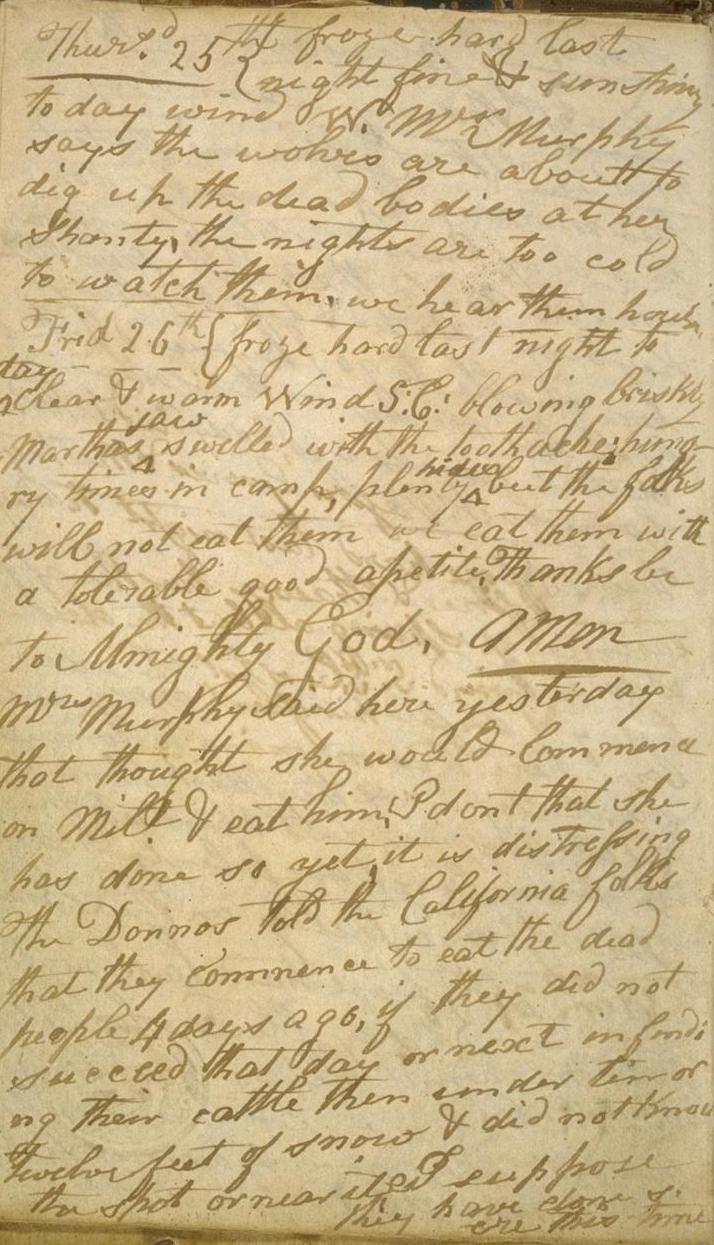
Diary from Patrick Breen expressing the horror in 1847. Photo via wikipedia.
“Mrs. Murphy said here yesterday that she thought she would commence on Milton and eat him. I do not think she has done so yet; it is distressing.” – Patrick Breen, 1847
Virginia Reed Murphy claims to have been a member of the only family not to resort to cannibalism to survive. Donner family members claimed that human flesh was saved for the youngest children, but admitted openly to cannibalism. The Donners settled in Alder Creek, where conditions were not as hospitable as they were in the Reed-Graves cabin.
Alder Creek was the hardest hit, and included the Donner brothers, their wives, and children. The family is thought to have eaten their dog, Uno, before resorting to something that made the trip historically infamous – cannibalism. One of the Donner’s former servants admitted to eating the remains of his master’s four-year-old nephew at the most desperate point of the journey.
And yet, the Donner Party was not alone, or without help and offers of food. Recent archeological evidence and conversation with tribal leaders of the Washoe tribe reveals a different, perhaps more tragic, story than what many of us are familiar with.
The Washoe were aware of the Donner Party’s presence, with their own settlement located just a few miles away, at a lower and more hospitable elevation. They tried to bring the pioneers deer meat, wild potatoes, and other game. Bones from these animals were found around the campsite, and as none of the survivors mentioned hunting during this time period, the native’s story supports the archeological findings.
Had the Donner Party recognized the help they were receiving and interacted with the tribe, they may all have survived their tragic ordeal. Unfortunately, at least once, the pioneers fired on the Washoe who brought them food. The tribe understood the desperation of the situation, however, and hung back looking for other ways to help – until they witnessed an act of cannibalism. At that point, the Washoe kept a wary eye on these strangers, but made no further move to save them.
The Donner Party’s fear and ignorance of the offer of good will, cost them dearly.
Rescue & Absolution
Leaving the mountains was a difficult task, made possible in large part by the banishment of John Reed. While the Donner Party stopped on their route, held down by the wagons and belongings they brought with them, John Reed was able to travel on. He left signals for his family that he was eating, strong, and healthy. At one point he nearly starved, but received aid from Stanton, another member of the trip who had traveled ahead and was returning to the group. Reed continued on to Sutter’s Fort.
When the terrible predicament of the Donner Party was discovered, John Reed traveled to California and begged for help. He asked until he received what his family needed – supplies, rescuers, and hope. Eventually, over several grueling trips, the surviving members of the Donner Party made their way to California.

Stumps of trees cut at the Alder Creek site by members of the Donner Party, photograph taken in 1866. The height of the stumps indicates the depth of snow. Photo via wikipedia.
Keseburg, the German immigrant who was behind Reed’s banishment, was accused of murdering Tamsen Donner and eating her while waiting for the final rescue party to save him. He was also found to be in possession of $247 that belonged to the Donners. At one point, he was almost brought to trial, but after an interview, the man who was behind the investigation into Keseburg dropped the case. Tamsen Donner is, as a result, a subject of much curiosity for historians and of fascination for the general public.
Investigating the Donner Party Today
Today, with highways crossing the Wasatch, Sierra Nevada, and Rockies easily, you might have a hard time picturing what life was like for pioneers. The Donner Party’s story is one of the most harrowing, and a good reminder of what life was like for many of our ancestors.
Visit the Memorial
If you take the same path the Donners did, today you will find the Donner Memorial State Park of California. This park is home to the site of Alder Creek and Truckee (now Donner) Lake. The location has been known for years, and even during the Gold Rush of 1849, served as a reminder to travelers that they should hurry on their way. The park itself was created in 1928 on an 11-acre lot, and has gradually expanded, as has visitor attendance.
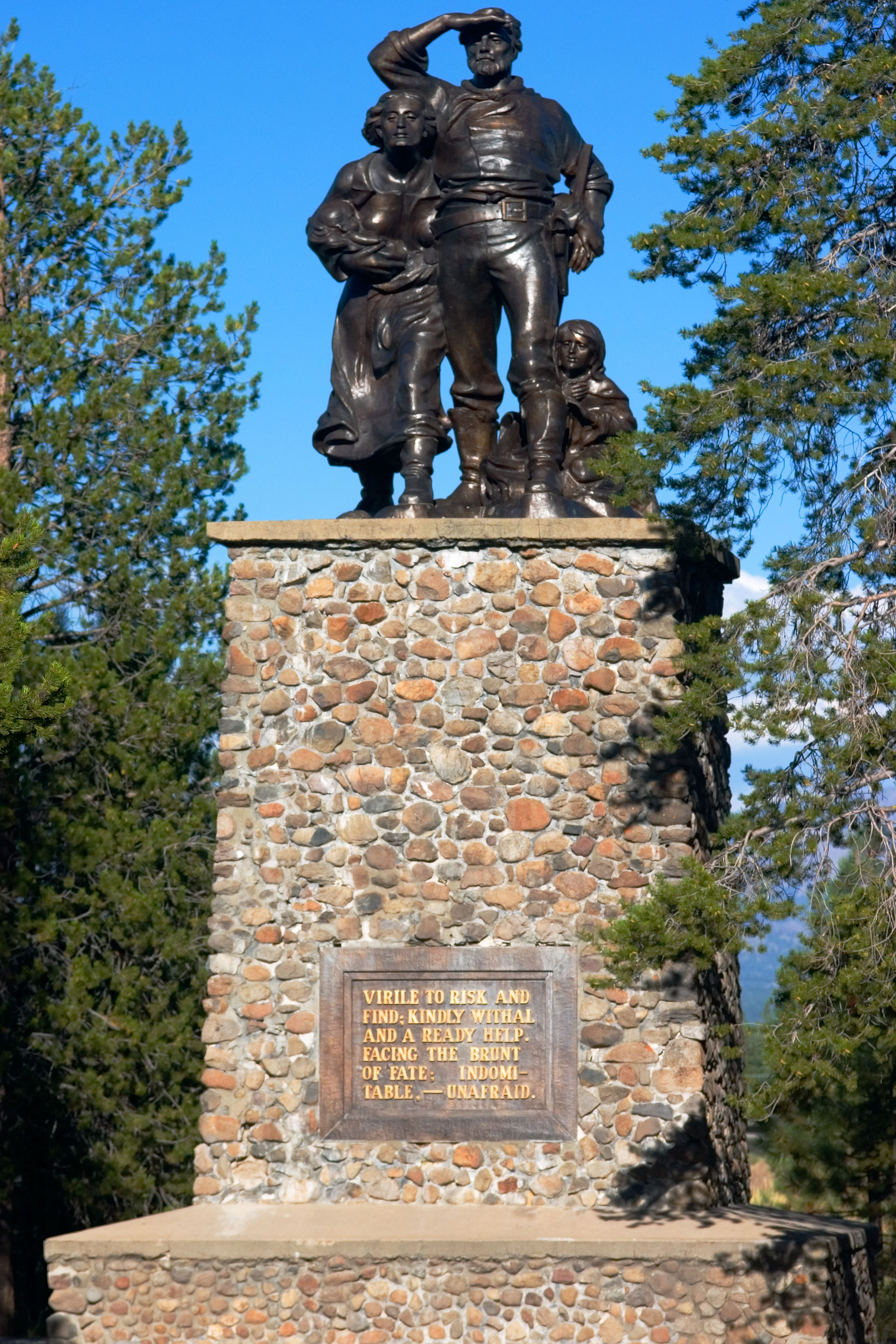
Statute at Donner Memorial Park. the top of the 22-foot (6.7 m) pedestal indicating how deep the snow was during the winter of 1846–1847. Photo via wikipedia.
A memorial in this park honors the Donner Party members, and reminds us of their struggle. The Emigrant Trail Museum in the park gives visitors the chance to see what life was like to the people who crossed the country by wagon train, and especially those who made their crossing through the High Sierra, like the Donner Party.
Kristin Johnson created a page of resources on the Donner Party that is worth mentioning as well. Although last updated in 2006, you may find the resource a great place to start learning about the Donner Party’s tragic history.
References
- http://www.history.com/topics/donner-party
- http://www.eyewitnesstohistory.com/donnerparty.htm
- http://news.discovery.com/history/us-history/donner-party-cannibalism-remains-111010.htm
- http://www.pbs.org/wgbh/americanexperience/features/introduction/donner-introduction/
- http://archive.archaeology.org/1205/letter/donner_party_alder_creek_washoe.html
- http://digital.library.upenn.edu/women/reed/donner/donner.html
- http://www.parks.ca.gov/pages/503/files/Desperate_Dreamers_DonnerSP.pdf
- http://www.parks.ca.gov/pages/21299/files/donner%20gp%20vol%201%20final.pdf




